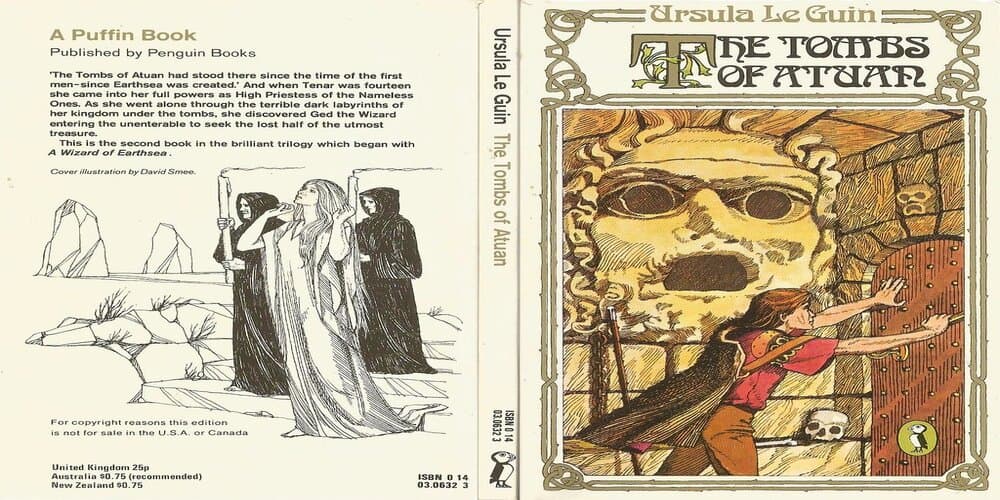
| Genre | High fantasy |
| Author | Ursula K. Le Guin |
| Language | English |
| Number of Pages | 163 |
| Release Date | 1971 |
The Tombs of Atuan by Ursula K. Le Guin is the second book of the Earthsea cycle. The novel was published three years after A Wizard of Earthsea, the first one from the cycle. The main character and the place where everything happens are different from the first book. Ged and a broken piece of metal connect the two novels.
In A Wizard of Earthsea, we learned about the area of Earthsea known as Karg Islands. In The Tombs of Atuan, the readers discover more about Kargs and their lands.
The main character, Tenar, the high priestess to the ancient Powers of the Earth, lives on one of the Karg Islands. Everything was taken away from her while she was a little girl – her name, family, and possessions. She lives among the walls of the place where the temples are located with other pristesses. She has only one purpose – to serve the Nameless Ones. Everything changes when Ged comes to Atuan searching for the piece of the ring of Erreth-Akbe. The girl faces doubts and difficult decisions. The Tombs of Atuan is the first Le Guin’s book, and the first high fantasy novel, with a female main character.
Karg Lands and Atuan
Karg Lands are four islands on the northeast of Earthsea – Karego-At, Hur-at-Hur, Atuan, and Atnini. In A Wizard of Earthsea, we realize that Kargs don’t have much contact with the Archipelago. Consequently, the knowledge about these islands and the Karg people is limited. Kargs are seen as primitive and warlike. Interestingly, Le Guin describes them as white-skinned. On the other hand, civilized and peaceful people of the Archipelago, as they see themselves, are dark-skinned. She doesn’t talk about that too much. Her intention could easily stay unrecognized. However, the message is there, and it wouldn’t be good if she sent it in a more intrusive manner.
While in other areas of Earthsea a religion is an unknown concept, Kargs respect The Nameless Ones, Twin Gods, and the God King who rule the lands. There are priestesses who worship them in the isolated temples on Atuan through the rituals.
The oldest temple is dedicated to the Nameless Ones who existed from the beginning. In the first two books, they are seen as dangerous and symbolize darkness. In A Wizard of Earthsea Ged doesn’t want to use the stone of Terrenon because he senses the ancient power in it.
Below the dusty temple of the Nameless Ones and the ancient stones, there are dark tombs and labyrinths that only the high priestess can walk through.
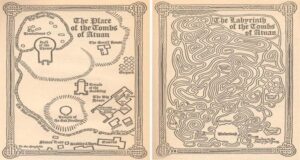
Maps of The Place from The Tombs of Atuan that shows the exact positions of the temples (Hall of the Throne or Temple of the Nameless Ones, Temple of the God King, Temple of the God Brothers) and everything between the walls of the Place, as well as The Labyrinth
Archa – The Eaten One
The high priestess of the Nameless Ones comes to the complex of temples at a very young age. Tenar was taken away from her family as a little girl. Through the ritual she gets the name Archa, meaning The Eaten One. As she grows older, she forgets her first, and true name, her family, and her place of birth. From other priestesses, she learns her duties and how to go through the dark underground passages without using the light.
The way the priestesses between the walls of The Place live and some rituals remind us of the sisterhoods in the Christian monasteries. However, leaving the name that these girls got when they were born is much more than getting a Christian name at the start of a new life dedicated to Christ. Archa and other priestesses are literally the tools of the powers they serve, and these powers are real, their actions can be seen and felt.
Of course, If you live in isolation from the age of five, you know only the place where you live and the things that a limited number of people tell you. The chances of becoming curious and even rebellious are very thin. So Archa accepts her destiny. Still, when she has to order to kill prisoners that God King sent to Atuan, to sacrifice them to the Nameless Ones, we see a spark of hesitation. Later, her sense of guilt is clear. Therefore, Ged didn’t change her. He helped her to find her true self, but she’s been already wondering about right and wrong when she met him.
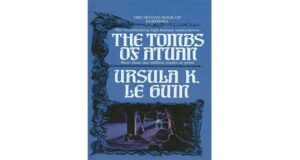
Ged’s role in Archa’s way of finding her true self
Ged enters the story as a stranger who came to steal the treasure from the underground treasury. Archa sees him with the light where no light is allowed (nor man presence). She closes the door of the labyrinth and leaves him there. The young priestess knows what her duty is. She must kill the intruder. And yet, she starts to wonder If that’s the right thing to do, and If there’s another way, what it would be. Since Thar, the High Priestess of the Twin Gods who was a mother figure to Tenar, passed away, the girl decides to tell what she saw to Kossil who is not fond of her.
Archa and Kossil – the High Priestess of the God King
From the description of the temples, the reader finds out that people don’t respect The Nameless Ones as they used to do a long time ago. The temple is full of dust and cobwebs, no one cares to fix anything, and no one comes on pilgrimage. Two other temples look better, particularly the Temple of the God King.
Although The Nameless Ones are the oldest and the strongest power, and Archa the highest priestess, it is just a form. Kossil, the High Priestess of the Godking, knows that. She sees herself as the most powerful person in The Place, not Archa. This leads to a conflict between them that escalates when Archa tells Kossil about the intruder. Kossil clearly says that her God is the one with the real power. “They are old. Their worship is forgotten, saved in this one place. Their power is gone. They are only shadows.”, says she about the Nameless ones. Archa realizes that the God Kings’ priestess don’t truly believe in gods. She serves the power aiming to get some for herself.
The only person who is completely loyal to Archa is Manan, her old eunuch guardian. He doesn’t agree with Archa and thinks she should kill the wizard, but he follows her orders. However, in the end, he decides to stop her from saving Ged. From his point of view, the decision is not against Archa. He believes he helps her.
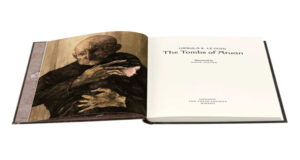
Tenar’s desire for knowledge
What Archa knows about people and wizards from the Archipelago is that they are fraudsters. For a long time, wizards have been trying to steal the treasure from Atuan. Kargs don’t believe in magic and think of wizards as liars and illusionists. So when Archa sees one in the underground tomb, she knows what he’s looking for. She wants to leave him to die in the Labyrinth, but there’s a guilt for leaving the prisoners to die down there that makes her hesitate. Furthermore, she wants to know If everything Thar and Kossil told her about the wizards was true. She’s never seen anyone from the Archipelago, she wants to use the opportunity to find some answers by herself. So the young girl starts helping Ged to survive in the Labyrinth and talks to him.
Trust between Tenar and Ged is the key
The Tombs of Atuan is a novel about trust and its importance. Neither Ged nor Tenar could find what they were looking for without mutual trust and help. Both of them would die on their way If they hadn’t relayed on each other.
Conversations between Archa and Ged are crucial for building trust between the Archipelago Wizard and the Karg Priestess. Archa learns about a culture unknown to her. Same with Ged – he is not familiar with the Karg people and culture so he learns too. They hear from each other unknown stories. Le Guin masterly highlighted the importance of storytelling.
The Wizard is honest with the priestess from the very beginning. He explains that he searches for the missing part of the ring of Erreth-Akbe that must be whole to bring the piece to the world, tells the story about the Karg woman from the isolated little island who gave him one piece and the dragon who told him what that piece was. They exchange versions of stories about the lost part of the ring of Errteth-Akbe.
As the ultimate guest of trust, the wizard tells his true name – Ged, not Sparrowhawk. As wizards can discover someone’s true name, Ged discovers Archa’s and calls her Tenar – the name she forgot and now remembered it. By remembering her true name, her identity comes back.
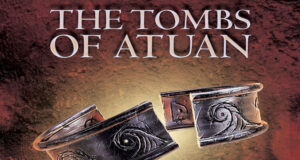
Being Archa or Tenar – the final choice
Kossil knows that Archa lied when she said she killed Ged. Not knowing what to do, Archa goes to the treasury where she hides Ged. He tells her she has two choices – being Archa and killing him, or being Tenar and escaping with him. Le Guin demonstrates Nomen est omen principle, important on Earthsea, in the most obvious way in The Tombs of Atuan.
The decision is not easy. The girl doesn’t know anything about the outside world and people, she doesn’t know how to do anything except the rituals, underground passages represent her world where she has power and purpose. The freedom may be outside, but what would she do with it? She is someone only inside the walls and in the dark. Still, she boldly decides to escape.
Tenar and Ged connect the pieces of the broken ring (it turned out that it was a bracelet made for a woman’s hand). She leads the way while Ged uses all his magical powers that are weak in the place where The Nameless Ones are so strong, to keep their minds clear.
Killing Manan was maybe even harder than deciding to get away from The Place because he was the only person who truly respected her and cared for her. But once she decided to leave with Ged as Tenar, she couldn’t just change her mind and become Archa again.
Main character in The Tombs of Atuan analysis
Although everything that happens in the Tombs of Atuan Le Guin shows to the readers from Terar’s perspective, some critics claim that Ged is the main character because he’s the one who initiates the action. There are even those who go so far as to claim that the whole original trilogy is about Ged, and that Tenar is not important at all.
Our opinion is that Tenar is the main character of this novel, while Ged is the main character of A Wizard of Earthsea whose way we still follow through other novels, alongside the main character of these later books.
Tenar could never succeed without Ged
Some critics base their statement about Ged as the main character on the opinion that Tenar wouldn’t get her identity back without him. Every once in a while, she sees her mother in dreams, the woman calls her, but Archa can’t hear the name. Ged calls Archa by her true name. She would never get her identity back alone. That may or may not be true. How can we be so sure that she wouldn’t remember her name one day? She had these dreams, is it so hard to imagine that in one of them, she would hear what her mother calls her?
Even If we take as a fact that she would stay Archa forever without Ged, it still doesn’t make Ged the main character. It’s not like only he helped her, she also helped him. His mission would fail without her. And not only his mission – his life would be over If Archa, who already had her doubts (we mentioned that earlier), didn’t help him.
The Tombs of Atuan is Tenar’s story
Le Guin doesn’t mention Ged in the Prologue which sets the main theme of the novel. He shows up later. And If heroes in high fantasy novels often have helpers, in this case, Ged could be Tenar’s helper. He does initiate the action, but Tenar is the central character of that action.
The Tombs of Atuan is a novel about Tenar’s growing up in a specific system of rules and beliefs, and her search for identity despite the circumstances that deny it.
Tenar didn’t want to become a priestess, no one asked her or her family about their wishes. The girl was born at the moment that marks her as the reincarnation of the previous High Priestess. When she was five years old, she was taken away from her family. She didn’t have a childhood, parents, or home.
Deep inside she misses the part of her life that was taken away from her and she tries to make it up by reminding herself that she was special and important. She often asks Manan about the way they found her and the day they came for her – it’s a story about her uniqueness. Also, she often shows pride reminding us of young Ged in A Wizard of Earthsea in those moments. But while pride leads Ged to mistakes and suffering, Tenar simply expresses normal characteristics for a child, only much stronger because unlike other children she is alone in an unhealthy environment. She wants the company and human touch because Archa or not – she’s just a child.
“They can’t punish me. They don’t dare. They can’t touch me. I am Archa,” she said in a shrill, fierce voice, and burst into tears.
She wouldn’t mind being punished, just to feel the physical contact. But Archa is untouchable.
The scene where she leaves with Ged and the Labyrinth behind them collapses could be a symbol of leaving her trauma behind. She can’t get back home to her family, but symbolically, going to a different place could substitute for going home. She goes into the unknown world, but it is the world where she can have things she missed – normal life and connection with other people. The new world frightens her, but she bravely chooses to go into the unknown.
Tenar is a hero in The Tombs of Atuan
Opinions that a powerful wizard makes also a powerful priestess an ordinary girl are unacceptably simplified. In the Labyrinth, neither of them is so powerful. Ged loses most of his power so close to the Nameless Ones, while Archa possesses the power that she pays with a lack of identity. She’s far from ordinary when she becomes Tenar. Ged himself acknowledges her as a hero:
“I’ll take you to the Havnor and say to the princes of Earthsea, ‘Look! In the place of darkness, I found the light, her spirit. By her an old evil was brought to nothing. By her I was brought out of the grave. By her the broken was made whole, and where there was hatred there will be peace.’
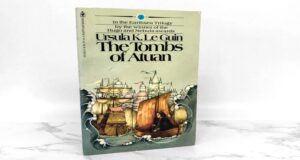
The Tombs of Atuan as anticipation of innovations in high fantasy
When The Tombs of Atuan was published in 1971, it was praised by critics and readers as something new in the high fantasy genre where there was no proper place for female characters. However, later critics weren’t satisfied. They claimed that Le Guin made Tenar inferior to Ged, so initial prices were replaced with condemnation. How’s that possible?
The problem is that later critics couldn’t help themselves but compare The Tombs of Atuan with the so-called second trilogy of the Earthsea Cycle. Their complaints were coming from the feminist point of view although Le Guin didn’t even try to make a feminist novel. Her intention was to experiment with new characters and topics. Bearing that in mind, the book was a success. Le Guin opened some questions that she will develop in her later novels.
Searching for something we know Le Guin incorporated in her later work in The Tombs of Atuan leads us to the sidetrack. This is a novel about trust and the unity of male and female principles. It makes perfect sense If we remember that everything on Earthsea is about balance. Also, the two cultures meet through Ged and Tenar. Women from Karg Lands and men from Archipelago together connect the Ring of Erreth-Akbe and bring the promise of peace to the world. Le Guin perfectly presented the message that only unity leads to salvation for the world as well as for individuals. Too bad that anyone can see in this unity the triumph of the male principle over the female and find The Tombs of Atuan as a failure because of that.

